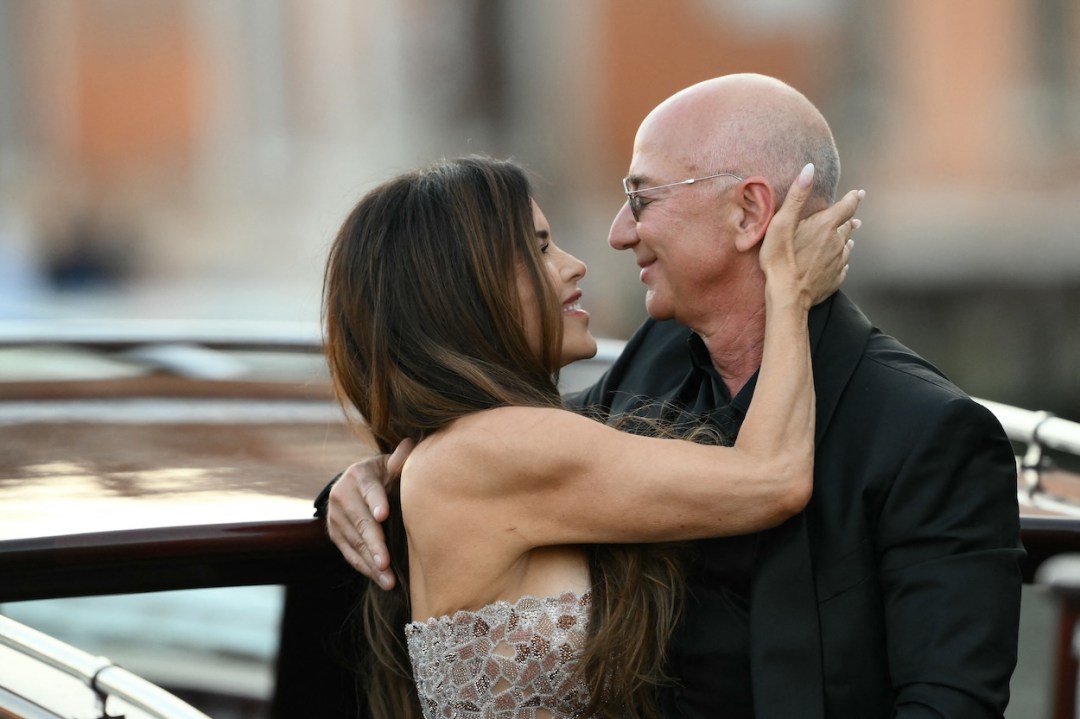Jeff Bezos has brought much tat into the world, along with the undoubted convenience of Amazon’s services. But in at least one respect, he is a man of good taste. In choosing Venice to plight his troth with his lovely bride Lauren Sanchez at the weekend, Bezos picked the best possible location: La Serenissima is indeed a veritable miracle.
It is a logic-defying wonder, and despite my frequent visits, I still don’t understand the physics of its construction. How can a city of hundreds of heavy palaces and churches, resting on petrified wooden piles driven into mud, continue to exist centuries after the Venetian lagoon was first settled by terrified refugees? Those who founded the city were of course fleeing the fury of invading barbarian hordes of Huns and Visigoths laying waste to the rest of northern Italy.
It was probably that same remoteness of the 100-plus islands that saved Venice for civilisation. Those refugees evolved from precarious fishermen into a magnificent maritime empire, based on a miraculous floating city that is still – I make no apologies for claiming, though it is hardly an original suggestion – the most gorgeous and romantic place in the world. How can anyone resist a city without cars, where water rules supreme and, instead of buses or Tube trains, you take a speedy vaporetto to your desired destination? Just to be afloat here soothes the most jangled of nerves.
I first visited Venice aged five. The only memories I have of that trip are of a drunken British sailor from a visiting warship reeling around St Mark’s Square yelling ‘Fred!’ and the coloured glass globules adorning the wrought-iron gateway into Peggy Guggenheim’s gallery on the Grand Canal.
Peggy, like Bezos, was just one of many super-rich celebrities lured to Venice by its glitz. Since its empire declined from the 16th century onwards, La Serenissima has depended on tourism and its reputation – appropriately for Casanova’s home town – as the place to go with your lover.
I have been to Venice perhaps 30 times since that first visit. I have my own favourite modest hotel tucked away near St Mark’s and would stay there for good if I could. Yes, I know all the clichés: Venice is thick with touts and pickpockets; it stinks in summer; it’s overpriced and overwhelmed with day-trippers from the giant cruise ships that are going to finally capsize the sinking city; Venice is dying with a shrinking population the size of Brighton and Hove. Despite all these half-truths, ‘trotz alledem’ as the Germans say, I would like to end my days there.
Many have done precisely that, both in fact and fiction. Just as some places – like Rome and Paris – are cities of life, so others like Venice and Vienna are cities of death, shaded by gloom and giving off a faint air of dissolution. Wagner died here, in the superb palazzo Ca’ Vendramin Calergi on the Grand Canal which now houses the Casino, and Browning passed in another, the Ca’ Rezzonico, acquired by his son Pen thanks to his marriage to an American heiress.
I never see the ATM in the corner of St Mark’s Square without her jibe ringing in my ears: ‘That will be 150 euros for services not rendered’
In fiction, the writer Gustav Aschenbach found both lust and death in Venice, via the pen of Thomas Mann – a novella memorably realised on screen by Luchino Visconti in Dirk Bogarde’s finest performance. My three favourite Venetian films are all about death, the other two being Don’t Look Now, a macabre tale by Daphne du Maurier, which includes the most erotic encounter ever seen in a mainstream movie, and The Comfort of Strangers, based on an Ian McEwan novel which sees a sinister Christopher Walken murderously obsessed with Rupert Everett.
All these films mingle Eros with death and for me that is part of Venice’s draw. You don’t expect a honeymoon here to be entirely happy, as Mr John Cross discovered when he took his 60-year-old bride George Eliot there. For reasons still unexplained, young Mr Cross leapt from his hotel room into the Grand Canal and was fished out by gondoliers rather than perform his conjugal duty with the eminent novelist. A similar fate befell the great critic John Ruskin, who introduced Venetian architecture to the Victorian public. Ruskin was so shocked by the sight of his bride Effie Grey’s pubic hair that it completely unmanned him (his only previous sight of a naked woman having been on classical statues). The marriage was later annulled due to non-consummation.
The one time that I went to Venice with seduction specifically on my mind, fate also failed to deliver the anticipated outcome for me. To add insult to injury, the lady concerned asked me to pay her airfare home to Berlin. I never see the ATM in the corner of St Mark’s Square without her jibe ringing in my ears: ‘That will be 150 euros for services not rendered.’
So if not romance, what is it that makes me adore the place? It is the mystery of this maze, and a definite air of menace. In the evenings, when the tourists have gone back to their ships and the shadows lengthen, you can wander alone and lose yourself in the heart of the labyrinth. There is a thrill in not knowing who or what will be around the next corner. And if it turns out to be a hideous knife-wielding dwarf in a red mac, a beautiful boy in a sailor suit or indeed Jeff Bezos – why, that would be exciting too.








Comments